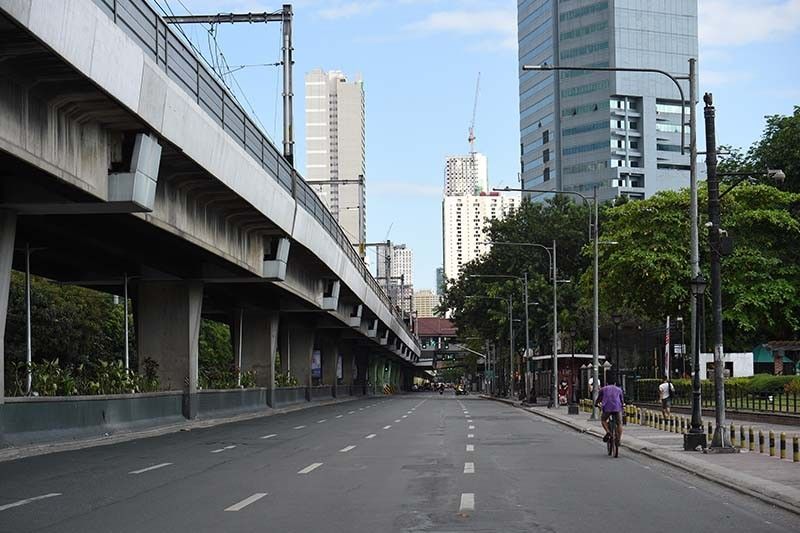With roads clear, Metro Manila breathes in cleaner air during lockdown

MANILA, Philippines — The coronavirus pandemic has infected over 400,000 people across the globe, pushed economies on the brink of collapse and put a number of countries on unprecedented lockdowns. But there is one thing benefiting from the stoppage caused by the outbreak: the environment.
Although not by choice, air quality in the densely populated Metro Manila is improving due to dramatic reduction of vehicles in the road as people stay at home and public transport got suspended for a month-long community quarantine of the entire Luzon island ending April 12.
The cleaner air in the capital is a tiny bright spot in the beleaguered Philippines, which is facing an escalating health crisis due to the spread of coronavirus disease-2019 (COVID-2019) that has infected 636 people, 38 of whom died as of Wednesday afternoon.
Twelve days since the Luzon lockdown was initiated in March 13, the average level for particulate matter of 10 microns (PM10) in Malabon City dropped to 19 micrograms per normal cubic meter of air (µg/Ncm) on Wednesday, while in Marikina it fell to 11 ug/Ncm, data from the Environmental Management Bureau of the Department of Environment and Natural Resources. Both readings were classified as “good,” which means breathing air poses little to no risk to individuals.
The gauge used by EMB measures PM10 a tiny microbe that can penetrate and lodge deep inside the lungs when inhaled. When exposed extremely to PM10, people may develop coughing, wheezing and even trigger asthma attacks and bronchitis. The World Health Organization identifies the safe levels of PM10 as under 20 µg/Ncm.
Elsewhere in Metro Manila on Wedneday, PM10 levels were also recorded low in Pasig City (17 µg/Ncm), San Juan City (33 µg/Ncm), Taguig City (33 µg/Ncm) and Quezon City (5 µg/Ncm). The PM10 level in North Caloocan was at 75 µg/Ncm, which means it poses “moderate health risk concern for a very small number of people who are unusually sensitive to air pollution.”
Air quality has improved since the days prior the lockdown. Last March 6, three days before the government declared a state of public emergency, the PM10 levels in North Caloocan (116 µg/Ncm) and Taguig (128 µg/Ncm) were deemed unhealthy for people with respiratory illnesses, while air quality in Navotas (68 µg/Ncm), Makati City (51 µg/Ncm), Mandaluyong (99 µg/Ncm) and Parañaque (56 µg/Ncm) were classified as “fair.”
180% decrease in PM2.5 levels
A separate reading using a different gauge of air quality by the Environmental Pollution Studies at the University of the Philippines-Diliman showed also some improvement. The office said air monitoring systems recorded as much as 180% decrease in PM2.5 pollution level since March 16.
Particulate matter of 2.5 microns or less in diameter is the most dangerous kind of airborne pollution. PM2.5 dusts are small enough to enter the bloodstream via the respiratory system and travel throughout the body, causing asthma, heart disease and lung cancer.
UP Diliman’s Environmental Pollution Studies noted there was a 80% to 180% reduction in the levels of PM2.5 from 9 p.m. to 4 a.m. at the Lung Center of the Philippines compound in Quezon City. There was also a 70% to 90% reduction in PM2.5 level along EDSA Muñoz since the enhanced community quarantine was implemented.
“On ordinary Thursdays, the PM2.5 would peak to 38 µg/m³ during evening rush hours, which can be unhealthy to sensitive groups,” Dr. Mylene Cayetano, technical adviser of www.airtoday.ph, said.
Last year, the Philippines’ annual mean for PM2.5 was pegged at 17.6 µg/m³, according to the 2019 World Air Quality Report. The result was higher that the safety limit set by the World Health Organization at 10 µg/m and the country’s PM2.5 pollution level in 2018 at 14.6 µg/m³.
Short-lived changes
Over the past few days, images of bluer skies uploaded in social media supported the data that air quality has indeed improved in NCR, but experts believe the changes may be short-lived.
“Without long-term solutions to air pollution due to vehicle emissions, this cleaner air experience is short-lived. Expect normalcy in pollution levels after the enhanced community quarantine,” Cayetano said.
Declines in emissions during crises are usually followed by a rapid upsurge, the World Meteorological Organization said.
“The world needs to demonstrate the same unity and commitment to climate action and cutting greenhouse gas emissions as to containing the Coronavirus pandemic,” WMO Secretary-General Petteri Taalas said on March 24. “Failure in climate change mitigation could lead to greater human life and economic losses during the coming decades.”
- Latest
- Trending






























